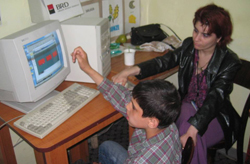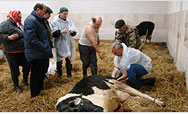You are here » Home » Telling Our Story
Success Story
Abandoned children and orphans find homes with foster families
Child Welfare Improves

| |
Photo: USAID/Jay Sorensen
|
|
A disabled child gets help with color awareness at the USAID-funded St. Ana Center in Bucharest, Romania.
The number of orphans in state institutions has dropped from 60,000 in 1990 to 23,000 in 2006.
|
About 20 disabled children play in a small park, watched by a handful of nurses at St. Ana Day Center. “I got this center going because institutions like this get no attention,” said Gabriela Scraba, the founder, whose autistic daughter attends the center.
During Nicolae Ceausescu’s dictatorship, family planning was illegal and orphanages overflowed with children, many of whom were disabled. In the 1990’s, family planning services still did not exist, and the government struggled to care for thousands of orphans. USAID’s current project called ChildNet addresses child abandonment and orphan care. After investing $16.4 million in training, technical assistance, and grants, the results are showing. The number of orphans in state institutions has dropped from 60,000 in the late 1990’s to 23,000 in 2006.
When USAID opened its doors in Romania in the 1990’s, orphans and abandoned children were put in state-run institutions. Poor families had no access to child care, so they would frequently abandon their children because, they thought, at least they would be taken care of by the government.
The project’s first goals were to reduce the number of children in institutions and provide services to vulnerable children of poor families. One solution for children whose families were not able to take care of them was foster care. Today, nearly 18,000 children are cared for by foster parents, up from zero in 1997. USAID also worked with the government to reform public child care. Foster parents are now considered state employees and receive financial assistance for raising orphaned children. In addition, disabled children receive financial assistance and free transportation and medical care, making it easier for families to care for them.
The program also funds places like St. Ana Day Center. These centers provide services ranging from daycare for disabled or abandoned children to rehabilitation and family support. Other centers provide training for rural officials, which helps them better understand the needs of such children and their families. The practice of abandoning children has not stopped entirely, but it has slowed down dramatically, and it will continue to decline as more poor families understand that, if they care for their own children, they can get help while raising them in a loving environment.
Print-friendly version of this page (440kb - PDF)
Click here for high-res photo
Back to Top ^ | 

